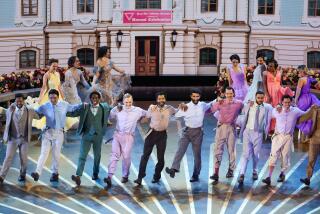Embodying the Hindu spirit
- Share via
In “Sarpagati: Dances of the Rising Serpent,” Ramaa Bharadvaj enlisted her considerable talents as a classical Indian dancer and choreographer to illuminate profound concepts in Hindu philosophy.
Presented Friday at the Norton Simon Museum, the six-part program offered vibrant, artful performances attempting to fuse images from sculptures in the museum’s collection with ideas from a text read with care and grace by Nimmi Raghunathan.
However, when slides of the sculptures popped up during the dances, the event veered dangerously close to the literalism of the Pageant of the Masters. And when the dances failed to express the texts but merely provided a decorative garnish, the project’s ambitions seemed misguided.
In “Ananda Tandavam,” perhaps the clearest, most effective segment, Ramaa and Swetha Bharadvaj (her daughter) strongly embodied the feminine and masculine energies of the Hindu deities Sakthi and Shiva. Contrasts in force and deployment of weight, facial expression and stance conveyed exactly what the narration described along with an extra dimension of dancer radiance.
But the audience had to take on faith the spirituality of “Prema Geetam.” Ramaa Bharadvaj mimed degrees of worry and petulance with great flair, and Shivali Panchal added another layer of charm, but union with the divine seemed at most an adjunct to this scene, never its essence.
Here and elsewhere, the dancers skillfully portrayed colorful characters, but only the narration made them into something more.
Swetha Bharadvaj, for instance, coiled and rippled her limbs effectively in “The Rising Serpent,” but it would take a different kind of choreography to make an audience see her as “Kundalini power.” Any dance can be made metaphorical by narration; the best ones do it themselves, wordlessly.
More to Read
The biggest entertainment stories
Get our big stories about Hollywood, film, television, music, arts, culture and more right in your inbox as soon as they publish.
You may occasionally receive promotional content from the Los Angeles Times.








